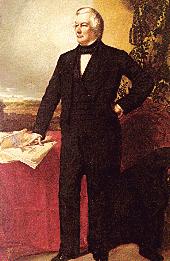Millard Fillmore: Difference between revisions
Jump to navigation
Jump to search

imported>Yi Zhe Wu (in popular culture) |
Pat Palmer (talk | contribs) m (Text replacement - "President of the United States" to "President of the United States of America") |
||
| (4 intermediate revisions by 3 users not shown) | |||
| Line 1: | Line 1: | ||
{{subpages}} | {{subpages}} | ||
{{Image|Mf13.jpg|right|350px|Millard Fillmore}} | |||
'''Millard Fillmore''' ([[January 7]], | '''Millard Fillmore''' ([[January 7]], 1800 – [[March 8]], 1874) was an [[United States of America|American]] politician and the thirteenth [[President of the United States of America]]. He succeeded [[Zachary Taylor]] when he died, and failed to secure the nomination for the next presidential election from the [[Whig Party (US)|Whig Party]]. | ||
==In popular culture== | ==In popular culture== | ||
*The title of politically [[American conservatism|conservative]] comic strip [[Mallard Fillmore]] by [[Bruce Tinsley]] is named after President Fillmore. | *The title of politically [[American conservatism|conservative]] comic strip ''[[Mallard Fillmore]]'' by [[Bruce Tinsley]] is named after President Fillmore. | ||
Latest revision as of 14:48, 24 February 2023
Millard Fillmore (January 7, 1800 – March 8, 1874) was an American politician and the thirteenth President of the United States of America. He succeeded Zachary Taylor when he died, and failed to secure the nomination for the next presidential election from the Whig Party.
In popular culture
- The title of politically conservative comic strip Mallard Fillmore by Bruce Tinsley is named after President Fillmore.
